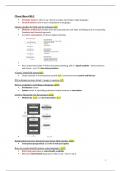Samenvatting
Summary Cheat Sheet - Natural Language Generation (INFOMNLG)
- Instelling
- Universiteit Utrecht (UU)
This cheat sheet contains the most important information from the course and refers to pages in the full summary for extra details. Everything is clearly highlighted.
[Meer zien]




